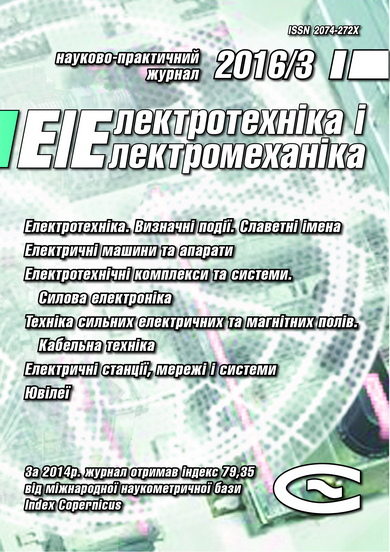A TECHNIQUE OF MEASURING OF RESISTANCE OF A GROUNDING DEVICE
DOI:
https://doi.org/10.20998/2074-272X.2016.3.08Keywords:
grounding device, resistance measurement, three-electrode installation, minimum spacing of measuring electrodes, technique of measuring, substitution circuitAbstract
Introduction. Measurement of resistance of the grounding device (GD) by means of a three-electrode system. This requires not only the right choice of installation locations of measuring electrodes, but also the determination of the point of zero potential. Implementation of these requirements quite time-consuming, and in some cases impossible. Aim. Develop a new technique for measuring the electrical resistance of the GD. Task. The method of measuring the resistance of the GD with the help of a three-electrode setup is necessary to exclude the determination of the point of zero potential. Method. Mathematical modeling and calculation engine. Results. A three-electrode system for measuring the resistance of grounding devices (GD) for various purposes is considered. On the basis of Maxwell equations a theoretical substantiation of a new technique for measuring the resistance of any GD of any construction in random soil structure has been proposed. An equation system of the sixth order has been obtained, its solution makes it possible to measure its own mutual resistance in the three-electrode installation with sufficiently high accuracy. Peculiarities of drawing up a calculation scheme of substitution of a three-electrode installation with lumped parameters: self and mutual impedance. Use of the principle of reciprocity eliminates the need of finding a point of zero potential which is a rather difficult task. The technique allows to minimize the spacing of measuring electrodes outside the GD, which substantially reduces the length of wiring of the measurement circuit and increases the «signal-to-interference» ratio and also removes the restrictions on the development of the territory outside the GD being tested. Conclusion. The procedure allows to evaluate the self and mutual impedance grounding all the electrodes in a three-electrode measuring installation of the grounding resistance of the device without finding the point of zero potential.References
1. Vainer A.L. Zazemleniia [Grounding]. Kharkov, GNTI Ukrainy Publ., 1938. 287 p.
2. Kostruba S.I. Izmerenie elektricheskikh parametrov zemli i zazemlyayushchikh ustroistv [Measurement of electrical parameters of the earth and ground grids]. Moscow, Energoatomizdat Publ., 1983. 168 p. (Rus).
3. Oslon A.B. Grounding devices on power lines and high voltage substations. Results of science and tech. VINITI. Ser. el. stations, networks and systems. Moscow, VINITI Publ., 1966, pp. 65-184. (Rus).
4. Kats E.L., Men'shov B.G., Tselebrovskii Iu.V. Grounding devices of electrical installations of high and low voltage. Results of science and tech. VINITI. Ser. el. station and networks. Moscow, VINITI Publ., 1989, vol. 15, 158 p. (Rus).
5. Burgsdorf V.V., Yakobs A.I. Zazemlyayushchie ustroystva elektroustanovok [Grounding device of electrical installations]. Moscow, Energoatomizdat Publ., 1987. 400 p. (Rus).
6. Oslon A.B., Kostruba S.I. Measuring the resistance of large grounding devices. Electrichestvo – Electricity, 2006, no.8. pp. 49-56. (Rus).
7. Oslon A.B. Tagg methods analysis for measuring grounding resistance. III Rossiiskaia konferentsiia po zazemliaiushchim ustroistvam: Sbornik dokladov [3rd Russian Conf. on Grounding Devices: Collected Papers]. Novosibirsk, Russia, 27-31 October 2008, pp. 111-120. (Rus).
8. Oslon A.B., Tselebrovskii Iu.V. The intersection of the potential curves and the resistance of the grounding device III Rossiiskaia konferentsiia po zazemliaiushchim ustroistvam: Sbornik dokladov [3rd Russian Conf. on Grounding Devices: Collected Papers]. Novosibirsk, Russia, 27-31 October 2008, pp. 121-130. (Rus).
9. Oslon A.B., Kostruba S.I. Mathematical modeling of the process of grounding resistance measurement current of industrial frequency in multilayer soil. Electrichestvo – Electricity, 2008, no.5, pp. 12-17. (Rus).
10. Neiman L.R., Kalantarov P.L. Teoreticheskie osnovy elektrotekhniki. Ch. 3 [Theoretical Foundations of Electrical Engineering. Part 3]. Moscow, Leningrad, Gosenergoizdat Publ., 1948. 343 p. (Rus).
11. RD 153-34.0-20.525-00. Metodicheskie ukazaniia po kontroliu sostoianiia zazemliaiushchikh ustroistv elektroustanovok [RD 153-34.0-20.525-00. Guidelines for the control of state-earthlings electrical devices]. Moscow, SPO ORGRES Publ., 2000. 64 p. (Rus).
12. SOU 31.2-21677681-19:2009. Viprobuvannya ta kontrol' pristroyiv zazemlennya elektroustanovok. Tipova іnstruktsіya [SOU 31.2-21677681-19:2009. Test and control devices, electrical grounding. Standard instruction.]. Kyiv, Mіnenergovugіllya Ukrayiny Publ., 2010. 54 p. (Ukr).
Downloads
Published
How to Cite
Issue
Section
License
Copyright (c) 2016 I. V. Nizhevskyi, V. I. Nizhevskyi

This work is licensed under a Creative Commons Attribution-NonCommercial 4.0 International License.
Authors who publish with this journal agree to the following terms:
1. Authors retain copyright and grant the journal right of first publication with the work simultaneously licensed under a Creative Commons Attribution License that allows others to share the work with an acknowledgement of the work's authorship and initial publication in this journal.
2. Authors are able to enter into separate, additional contractual arrangements for the non-exclusive distribution of the journal's published version of the work (e.g., post it to an institutional repository or publish it in a book), with an acknowledgement of its initial publication in this journal.
3. Authors are permitted and encouraged to post their work online (e.g., in institutional repositories or on their website) prior to and during the submission process, as it can lead to productive exchanges, as well as earlier and greater citation of published work.





